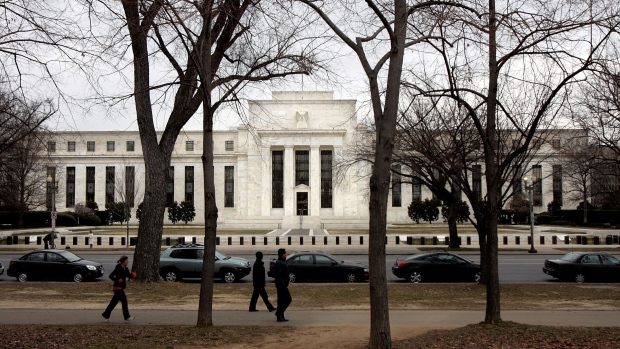Apr 26, 2024
Fed’s Preferred Core Inflation Gauge Rose at Brisk Pace in March
, Bloomberg News

(Bloomberg) -- The Federal Reserve’s preferred gauge of underlying US inflation rose at a brisk pace in March, reinforcing concerns of persistent price pressures that are likely to delay any interest-rate cuts.
The so-called core personal consumption expenditures price index, which strips out the volatile food and energy components, increased 0.3% from the prior month, data out Friday showed. From a year ago, it advanced 2.8%.
The overall PCE price measure also rose 0.3% from February and 2.7% from the prior year.
Inflation-adjusted consumer spending climbed a larger-than-forecast 0.5%, the biggest gain this year.
Faster inflation in the first quarter, combined with steady household spending, will likely persuade Fed policymakers to refrain from lowering interest rates — if at all — until later this year. Officials meeting next week are expected to hold borrowing costs at a two-decade high.
“There’s both a story here about the economy holding up very well with high interest rates, as well as inflation pressures being persistent,” Bruce Kasman, chief economist at JPMorgan Chase & Co., said on Bloomberg Television. “And while I don’t think it’s right to talk about this from the point of view of Fed tightening, I think the case for Fed easing here is pretty small any time soon.”
Traders mostly reacted positively as investors took relief from in-line monthly inflation data after quarterly figures on Thursday suggested upside risk to March.
Central bankers pay close attention to services inflation excluding housing and energy, which tends to be more sticky. That metric climbed 0.4% from February, an acceleration from the prior month, according to the BEA.
A robust labor market is the main reason why households have yet to hit the brakes on spending in the face of high interest rates and elevated prices. But a strong job market helps boost consumption and fan inflation even further, an outcome that is bad news for President Joe Biden’s campaign at a time when poll after poll show Americans are unhappy with the economy.
US consumer sentiment fell in April on dimmer views of personal finances and the economy as inflation expectations climbed, based on survey figures from the University of Michigan released Friday.
Goods Spending
Inflation-adjusted outlays for merchandise increased 1.1% last month, reflecting a second-straight month of solid spending on durable goods. Services spending, meanwhile, edged up 0.2%.
What Bloomberg Economics Says...
“Each month we can find idiosyncratic factors that help explain the elevated inflation pace — including rising insurance premiums and durable-goods prices — but the data suggest inflation will remain persistent in the year ahead.”
-Stuart Paul, economist
To read the full note, click here
Demand for workers is still healthy, supporting wage growth. Overall incomes increased 0.5%, as wages and salaries rose 0.7% for a second month. That was the strongest back-to-back gain since the start of last year.
The saving rate dropped to 3.2%, the lowest since October 2022.
Looking ahead, central bankers are still hopeful they can bring inflation down to their 2% target without breaking the economy.
A separate report out Thursday showed that slower economic growth in the first quarter masked resilient household demand and business spending.
--With assistance from Kristy Scheuble, Daniel Neligh and Christopher Condon.
(Adds with University of Michigan sentiment survey)
©2024 Bloomberg L.P.






